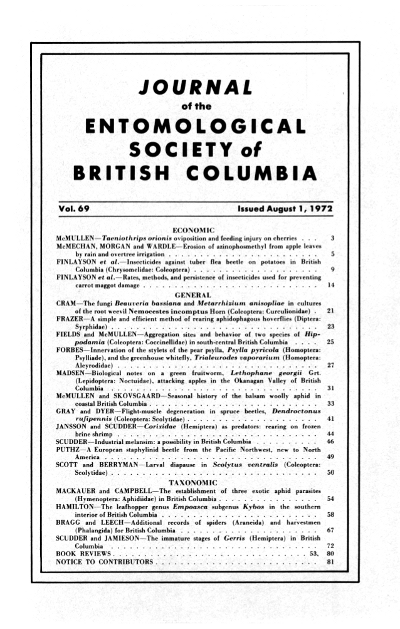Erosion of azinophosmethvl from apple leaves by rain and overtire irrigation
Abstract
Three sprays of azinphosmethyl wettable powder were applied for seasonal control of the codling moth, <i>Laspeyresia pomonella</i> (L.), in a semidwarf apple orchard. A rain of l.75 cm, occurring 6 hours after a spray application, removed 41% of the deposit from the leaves; a rain of l.00 cm, occurring 16 days after an application, did not remove any residue. Residues in the treetops were eroded more rapidly in blocks with overtree irrigation than in those with undertree irrigation. But there was no difference in the erosion rate in the overtree-irrigated orchard whether 5.1 cm of water was applied biweekly or 2.5 cm was applied weekly. There was a trend to poorer control of the codling moth with overtree irrigation.References
Ebeling, W. 1963. Analysis of the basic processes involved in the deposition, degradation, persistence, and effectiveness of pesticides. Residue Rev. 3:35-163.
Gunther, F.A., D. L. Lindgren, M.I. Elliot, and J.P. Ladue. 1946. Persistence of certain DDT deposits under field conditions. J. Econ. Entomol. 39:624-627.
Linskens, H.F., W. Heinen, and A.L. Stoffers. 1965. Cuticula of leaves and the residue problem. Residue Rev. 8:136-178.
Miles, J.R.W. 1964. A new colorimetric method for determination of residues of Guthion and Ethyl Guthion and their oxygen analogs. J. Ass. Off. Agric. Chem. 47:882-885.
Williams, K. 1961. Note on the effect of rain, and sprinkler irrigation, on the persistence of spray residues of Guthion and Sevin on apple leaves. Can. J. Plant Sci. 41:448-451.
Downloads
Published
Issue
Section
License
Authors who publish with the Journal of the Entomological Society of British Columbia agree to the following terms:
-Authors retain copyright and grant the journal right of first publication with the work simultaneously licensed under a Creative Commons Attribution License that allows others to share the work with an acknowledgement of the work's authorship and initial publication in this journal.
-Authors are able to enter into separate, additional contractual arrangements for the non-exclusive distribution of the journal's published version of the work (e.g., post it to an institutional repository or publish it in a book), with an acknowledgement of its initial publication in this journal.
-Authors are permitted and encouraged to post their work online (e.g., in institutional repositories or on their website) prior to and during the submission process, as it can lead to productive exchanges, as well as earlier and greater citation of published work (See The Effect of Open Access).


